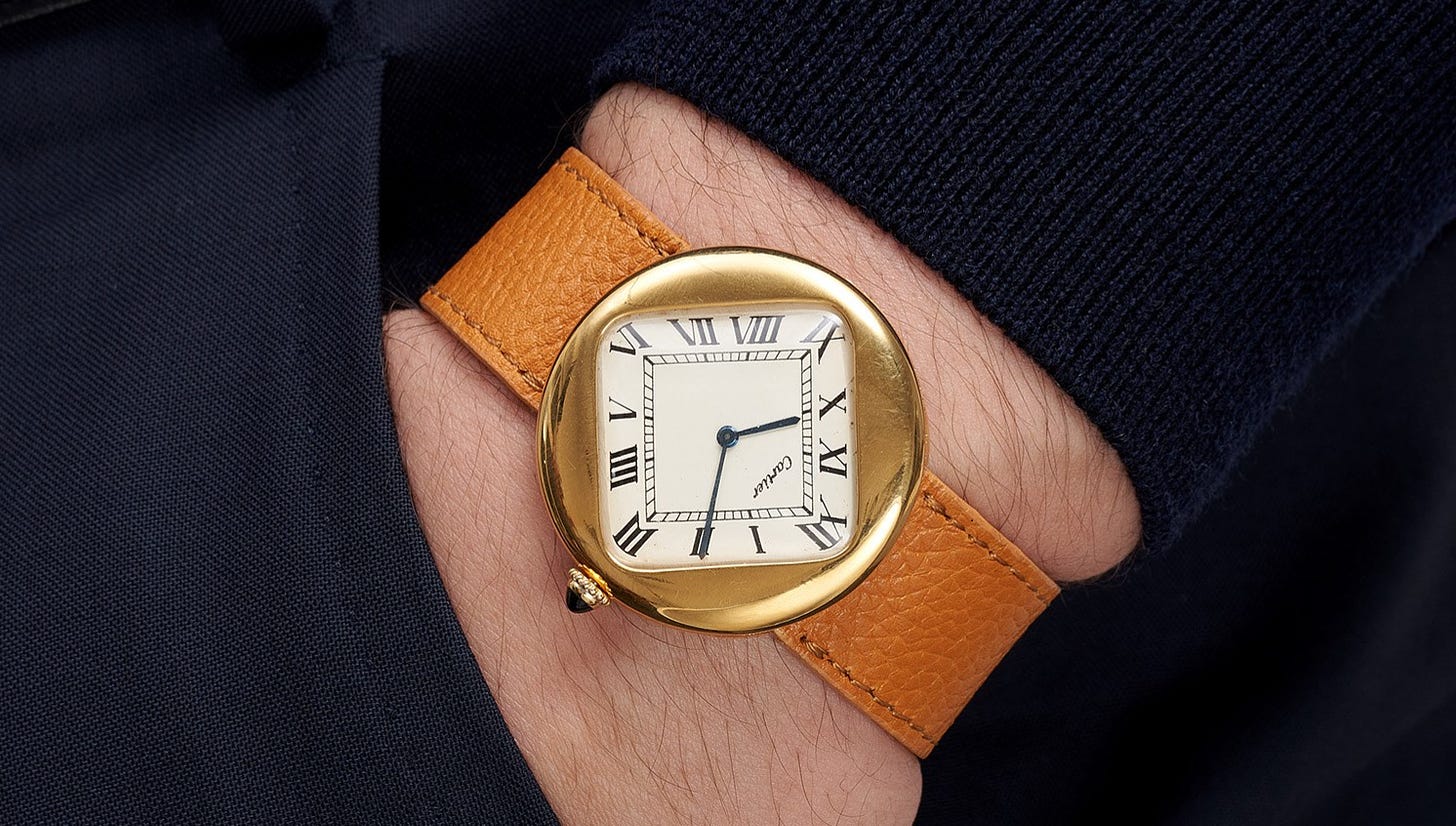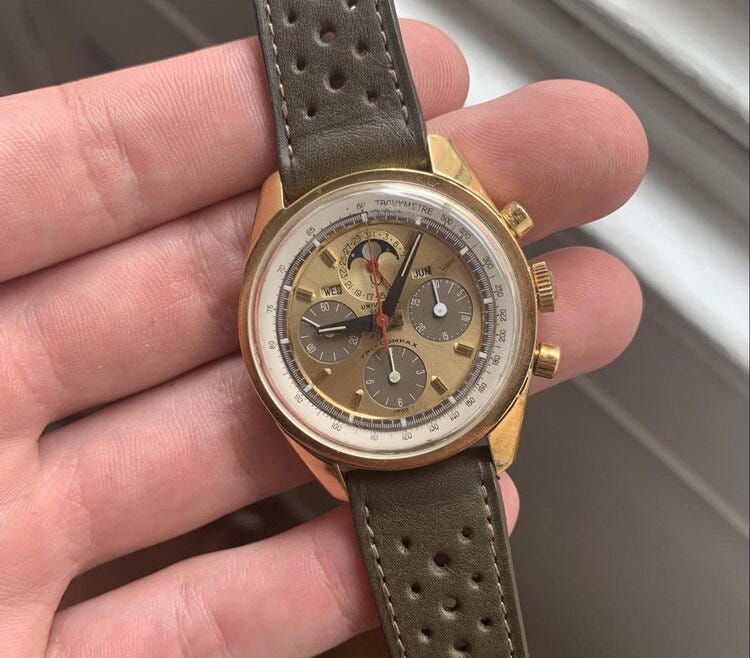Is now the best time to buy a Cartier Pebble, or the worst?
Or, what happens when 2 of 6 total examples of a watch come up for auction just a month apart
Rescapement is an independent and irreverent weekly newsletter about watches. Subscribe to get it delivered to your inbox every Sunday:

Imagine I tell you there are only six of something. It could be anything: watches, cars, geese a-laying.
But today, let’s say it’s a particular Cartier watch. One that looks like this. A Cartier Pebble, or “Baseball”, as it might be called by a brutish American, in what Cartier refers to as its Large size.
You wouldn’t necessarily expect to see one every auction season. And you don’t. But suddenly, the model is at the top of everyone’s mind: not one, but two appear in this particular auction season.
Such was the case with the Pebble this year: first, an example showed up at Phillips Geneva XIII. Then, just after the hammer came down on that watch, Bonhams released the catalog for their June auction in London, headlined by another large yellow-gold Pebble.
It raises the question: is now the best time ever to buy a Cartier Pebble, or the worst?
Our question could be answered in one of two ways. First, as a casual observer/someone writing a weekly newsletter about the fantastical happenings in the watch world, it’s amazing! Six of these things exist, and two (33.33%!) of them happen to come up for sale just a month apart. And if you do happen to be a potential buyer, you get the chance to evaluate not one, but two examples. Pick your poison, you savvy millionaire collector you.
Alternatively, if you’re a very serious collector only interested in very rare things, you might say to yourself, “self, I thought these Pebbles were only the rarest of the rare?” If you’re such a collector, only interested in the truly obscure shapes from Cartier London, you might find yourself wanting more. It’s kind of like Phillips selling four Patek 2499s in Geneva last month. I mean, these things are certifiable grails, but when you line up four (one from each generation), suddenly they don’t feel so special. You get numb to the rarity.
To be clear, I’m not suggesting that the supposed rarity of the Pebble has in any way been fabricated or exaggerated. Both auctions say there are probably 6 of the large Pebble. Noted Cartier connoisseur Harry Fane says the same (adding that there might be another 6 of the small Pebble, like this one). Goldberger, sprezzatura as ever, asks, why not have both (1, 2; he might also ask “why bother with yellow when you can have white gold”)?
That said, there is some element of the market and the auction houses bringing this on themselves. Nowadays, ever single lot has to be “possibly unique”, “highly rare” or “exceptionally important”. Hell, just last week one auction house held a sale titled An “Exceptional” (!) Season for Watches. That sound you just heard? It’s Hemingway rolling over in his grave at the use of superfluous adjectives.
So when something truly rare like the Pebble does come along, what are we supposed to do? It’s the boy who cried ‘rare.’
Let’s take a quick look at both of the Cartier Pebbles offered at auction this season.
Rescapement is an independent weekly newsletter. To get auction coverage like this in your inbox every Sunday, please subscribe:
Cartier Pebble from Phillips
First up, the Pebble that sold at Phillips Geneva XIII. The bidding action on this one was so exciting that I used the scene to open my auction recap article:
“And now, the big collectors start to get serious!” Aurel Bacs, screamed as bidding on the Pebble surpassed CHF 300k. Off an estimate of CHF 50-100k, it ended up selling for CHF 400k after a few minutes of frantic bidding.
The yellow-gold Large Pebble measures just over 35mm in diameter. This particular example dates to 1972, and Phillips points out that the same number is stamped on the case and the clasp, showing that the watch has remained with its original buckle. You’ll also see some English hallmarks on the clasp, as well as a “JC” stamp for Jacques Cartier, who led Cartier’s London branch during its most innovative years.
The Pebble is basically Jacques Cartier saying “square peg, round hole, but make it a watch.” The square dial’s resemblance to a baseball diamond has earned it the eponymous nickname and creates a striking aesthetic against the bold, round case.
At Phillips, bidding seemed to stall out around CHF 300k before a couple of serious collectors got in some sort of bidding war and chased the price up to its final sale price at CHF 400k. Could the same auction fever take hold at Bonhams London next month?
See lot 88 from Phillips.
Cartier Pebble from Bonhams

At first glance, the Cartier Pebble from Bonhams looks similar to the one sold at Phillips; however, there are some key distinguishing features. Most notable are the small “turtle feet” lugs protruding from the case. According to Bonhams, only one other Pebble features these lugs, and that one sits in Cartier’s collection.
Like the other example, the caseback and clasp are also stamped JC for Jacques Cartier. The Jaeger-signed movement is also stamped for Jacques Cartier, a cool detail signifying generations of collaboration between the two watchmakers.
Bonhams puts an estimate of $210-280k on this lot, so it’ll be interesting to watch if it’s able to attract the same intense bidding that the Phillips Pebble did. The clasp and case number don’t match here as with the Phillips example, but no biggie. Bonhams dates this example to 1975, a few years later than the previous example.
See lot 52 at Bonhams.
Like a Rolling Stone
As is often the case, the simplest explanation is probably the most accurate: the Cartier market is hot, so it’s pulling watches out of the woodwork, people eager to cash in on their Cartiers.
But back to the original question: Is now the best time or the worst time to buy a Cartier Pebble?
Harry Fane mentioned that the Phillips result “is a world-record price by far for any vintage Cartier watch.” Doesn’t that feel kind of surprising? I mean, not-as-rare Daytonas, Pateks, etc. seem to hit the millions on the regular, but no Cartier has even come close to touching seven figures? I get that the market for small, precious metal dress watches is smaller, but still. Once we hit what, a few hundred thousand dollars, isn’t any semblance of rationality basically thrown out the window anyway?
At least, spending a few hundred grand on a legit 1-of-6 watch is among the least ridiculous of ridiculous things we’ve seen in watches over the past year or so.
Through the Wire
John Reardon interviewing Ben Clymer is an absolute must-listen:
Speaking of Clymer, his 3.7k word rumination on the platinum AP was vintage Hodinkee. I won’t even try to summarize it.
And speaking of vintage Hodinkee: this week’s Talking Watches with Greg Selch might be the best one yet. We featured Greg about a year ago, so it’s cool to see his collecting philosophy further explored, as well as some of the same watches featured.

“Orphan watches” are a big theme of the episodes — brands or watches that, because they are lesser-known, aren’t collected in the same way more popular watches are.
”Collect knowledge, and then collect watches,” Greg says. “Try to learn as much as you can before you commit yourself to anything. You'll get a lot of satisfaction because you put something into it, finding something that maybe only you appreciate.”
Rescapement is an independent and irreverent weekly newsletter about watches. Subscribe to get it delivered to your inbox every Sunday. Follow us on IG too.






“Brutish American?” It has no resemblance to a baseball, but if it makes you feel better about wearing a woman’s watch, go for it.
For Harry Fane to say that the Pebble at Phillips “was a world record for any Cartier vintage watch” is utter nonsense. Easily verifiable. And he KNOWS that he’s wrong
Several Cartier have sold for more than US$500,000, and I believe the record is more like US$1mm - I think for a vintage Tortue minute repeater. It’s really troubling that Fane, who revels in being “THE Cartier expert,” would make up an easily confirmed fact when speaking to the press. What else has he exaggerated about?
An expert is only as good as their word, and Fane simply lying is just terrible.